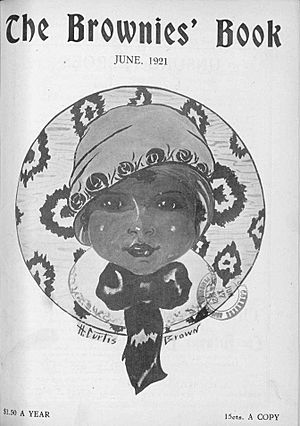The Brownies' Book facts for kids

Cover of the June 1921 issue
|
|
| Literary and managing editor | Jessie Redmon Fauset |
|---|---|
| Frequency | Monthly |
| Founder | W. E. B. Du Bois Augustus Granville Dill Jessie Redmon Fauset |
| First issue | January 1920 |
| Final issue | December 1921 |
| Country | United States |
| Based in | New York City |
The Brownies' Book was a special magazine made just for African-American children and young people. It was the very first of its kind! The idea for it was first shared in October 1919 in another magazine called The Crisis.
The first issue of The Brownies' Book came out in January 1920. This was during a time called the Harlem Renaissance, a period when Black art and culture really blossomed. The magazine was published every month until December 1921. Many people see it as a very important part of history because it helped start children's literature for Black kids in the United States.
Contents
Why The Brownies' Book Was Created
Three people worked together to create The Brownies' Book. They were also involved with The Crisis magazine, which was connected to the National Association for the Advancement of Colored People (NAACP).
The main editor of the magazine was W. E. B. Du Bois. He was also one of the people who helped start the NAACP. The business side of the magazine was handled by Augustus Granville Dill. The person in charge of the stories and poems was Jessie Redmon Fauset.
The Crisis and Its Children's Issues
Before The Brownies' Book started, The Crisis magazine had a special "Children's Number" issue every year. These issues included stories, photos, games, poems, and news about the achievements of Black children. They also talked about more serious topics, like important political events.
In the October 1919 "Children's Number" of The Crisis, W. E. B. Du Bois wrote an article called "The True Brownies". In this article, he announced that The Brownies' Book would be published soon. He said the first issue would come out the next month. Du Bois explained that the new magazine was "designed for all children, but especially for ours." It was meant for kids and teens between six and 16 years old.
Du Bois and Dill started their own company, Du Bois and Dill Publishers, in New York City. This company published each issue of The Brownies' Book.
Goals of the Magazine
One of the main goals of The Brownies' Book was to correct wrong ideas about Africa and its people. At the time, many children's books had unfair and untrue pictures of Africa. Black children often saw these same misleading ideas in other magazines.
Du Bois believed it was important for children to understand their own racial identity and social situation. He wanted them to know their history and feel proud. The magazine's name, The Brownies' Book, came from old stories about helpful little creatures called brownies. But the name also hinted at the history of Black people being used as servants. The creators wanted to change this idea. They specifically wanted to "make colored children realize that being 'colored' is a normal, beautiful thing."
Another goal was to add more stories and fantasy to Black children's literature. At the time, there weren't many fictional stories for Black kids. The magazine also wanted to encourage young people to join the NAACP. It aimed to help develop "The Talented Tenth" – a group of skilled African Americans who could become leaders in their communities.
Seven Key Goals
In his article "The True Brownies," W. E. B. Du Bois listed seven important goals for the magazine:
- To make colored children realize that being "colored" is a normal, beautiful thing.
- To make them familiar with the history and achievements of the Negro race.
- To make them know that other colored children have grown into beautiful, useful and famous persons.
- To teach them a delicate code of honor and action in their relations with white children.
- To turn their little hurts and resentments into emulation, ambition and love of their homes and companions.
- To point out the best amusements and joys and worth-while things of life.
- To inspire them to prepare for definite occupations and duties with a broad spirit of sacrifice.
Lasting Impact
The Brownies' Book has received more attention from critics than any other children's literature from the Harlem Renaissance. This shows how important it was.
After The Brownies' Book stopped being published, Du Bois and Dill Publishers closed down. Their only other publication was a book called Unsung Heroes by Elizabeth Ross Haynes, which came out in 1921.


